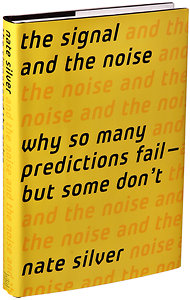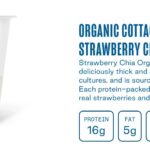 |
| Nate Silver’s The Signal and The Noise |
To a chef, a clean plate could indicate that the customer was famished and would have eaten everything or it could mean they loved the food and couldn’t put down their fork. How can an astute marketing professional distinguish between those two outcomes?
Marketers have many ways of establishing metrics for success like the percentage of emails opened, conversion rates or even how many people signed up for a newsletter. Surveys are another tool but I find it a very weak way to assess attitude. It can be so hard to gauge a human element as people check off boxes. (I always jump to the verbatims to find richer information).
But how can you make sure you aren’t kidding yourself and misreading behavior?
But how can you make sure you aren’t kidding yourself and misreading behavior?
Example: The New Sales Brochure
You create a terrific piece of sales collateral that solves a very specific market needs and delivers clear, crisps arguments and supports your case. . Your distributors and sales team all praise the effort and you take it as a sign of success that they keep ordering more and more. Is that they best way to determine if it is working? What were your expectations in creating the material and how do you plan on measuring success?
Time Matters
I’d start by speaking with the sales people who delivered the material. Ask them if they think it was helpful. How do they know it was helpful? What did they observe or hear from the customer that made them think that the collateral worked?
In doing this several years ago in another business, I spoke to 10 of our food brokers who had distributed some promotional material my team had created. The feedback I heard was that each of the brokers said that they got more time than normal with the customers because they were interested in the material we provided. Time is a great indication of success in that it’s often hard to get more than 20 minutes with a buyer. These reps all got over 35 minutes that day versus a typical 18 minute sales call.
Engagement leads to sales
Another sign they shared was that they felt the buyers were a little more engaged with them than normal. What they meant was they seemed more interested in listening to the pitch and it seems to indicate an increase in interest which is one of the goals. The buyer’s asked more questions and they wanted more details and information about the promotion. In general, the buyer’s level of energy was heightened and it was palpable. Our food broker reps could sense heightened interest as the sale collateral did the trick of sparking their imagination.
When we looked at the brokers who used the new materials and had successful experiences, we found that they did see a sales bump of about 10% year over year. Now that can’t be attributed just to the brochure- but it meant that what we did was a useful tool helping to support our sales effort. We got more quality time with the buyer, we could feel a heightened level of interest and ultimately all of this helped set up increased sales.
Back to our clean plate, imagine the chef coming out of the kitchen and speaking with his customers whose plates were clean, what could they ask to understand the difference between starvation, gluttony and true appreciation?
A feedback loop is vital
If I were the chef, I would ask the customers what part of the dish
 |
| Chef and the Clean Plate |
appealed to them most. Did they think the rosemary was the right compliment to the grilled grouper or would a more delicate herb have worked better like tarragon? Listening to the customer and watching how she talks about the food can tell you a lot.
If he says, you know I was so hungry, I could have eaten a horse than chalk one up for filling the belly. But if he says, I loved the way the flavors worked together, the fish was perfectly cooked and the parsnip puree that it sat on was perfection. Closing the feedback loop is the key to gaining deeper understanding of a consumer’s experience. You can see pleasure and enjoyment in the customer’s eyes as well as in their body language. Observing that customer talk about his meal may be all the feedback you need as you see the delight in their eyes.
Now, what’s for dinner?






I see how a blank slate can be helpful, but I prefer to work off past plans so that I can build and improve upon what has been done. I find that if I have to start from scratch, I forget key pieces. on A Blank Slate – this comment was from Heather but for some reason couldn’t get posted.